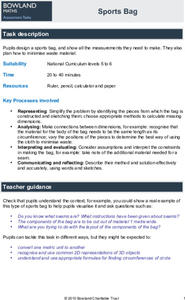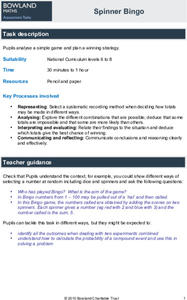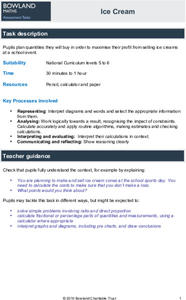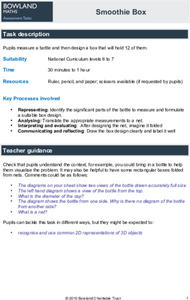Flipped Math
Calculus AB/BC - Limits at Infinity and Horizontal Asymptotes
Learning about end behavior means it's close to the end of the unit. The 16th of 18 lessons in Unit 1 - Limits and Continuity has scholars watch a video to learn how limits at infinity can be used to determine horizontal asymptotes and...
Flipped Math
Calculus AB/BC - Infinite Limits and Vertical Asymptotes
Infinite limits just got infinitely more interesting. The 15th of 18 installments in Unit 1 - Limits and Continuity looks at infinite limits and vertical asymptotes of rational functions. Scholars review how to determine the locations of...
Flipped Math
Calculus AB/BC - Removing Discontinuities
It's called a removable discontinuity for a reason. After reviewing the conditions for a removable discontinuity to exist, scholars watch an informative video to learn how to remove the discontinuity. They look at several examples...
Flipped Math
Calculus AB/BC - Confirming Continuity Over an Interval
Confirm one's expertise with confirming continuity over an interval. Pupils first review how to determine the domain of a function taking denominators, roots, and logarithms into account. They then connect this concept to continuity in...
Flipped Math
Calculus AB/BC Mid-Unit 1 Review: Limits
Limit the amount one forgets about limits. A mid-unit review lesson has individuals complete a learning exercise of problems on limits. They go over the meaning of limits, evaluate limits algebraically, use graphs and tables to find...
Flipped Math
Calculus AB/BC - Connecting Multiple Representations of Limits
It's time to put it all together. Viewers of an informative video learn to connect multiple representations of limits. Given algebraic, tabular, and graphical representations of a linear piecewise function, they determine whether a limit...
Flipped Math
Calculus AB/BC - Determining Limits Using the Squeeze Theorem
Sandwich the video in between lessons. Scholars learn about the Squeeze Theorem, or Sandwich Theorem, in the eighth of 18 videos in Unit 1 - Limits and Continuity. After seeing a few examples, they look at different situations to...
Flipped Math
Calculus AB/BC - Selecting Procedures for Determining Limits
Knowing more strategies is always a plus. Pupils watch an engaging video to learn additional ways to algebraically determine the limit of a function at a specified value. The video covers multiplying radical expressions by their...
Flipped Math
Calculus AB/BC - Determining Limits Using Algebraic Manipulation
Sometimes a little manipulation goes a long way. The sixth of 18 videos in Unit 1 - Limits and Continuity shows viewers how to use algebraic manipulation to determine limits. They first use substitution and factoring, then apply special...
Flipped Math
Calculus AB/BC - Determining Limits Using Algebraic Properties
Taking calculus doesn't mean one can forget all about algebra. Viewers of an educational video learn how to determine limits using algebraic properties. They apply basic operations to calculate limits and use substitution to find one-...
Flipped Math
Calculus AB/BC - Estimating Limit Values from Graphs
A one-sided limit need not be half as interesting as a two-sided limit. Pupils learn the notation for one-sided limits and how to determine the value of a one-sided limit from graphs by watching a short video. They then see how to create...
Flipped Math
Calculus AB/BC - Defining Limits and Using Limit Notation
There's no limit to what one can learn about limits. The second of 18 videos in Unit 1 - Limits and Continuity focuses on understanding the basic concept of a limit. Pupils learn the definition of limits and see how to determine a limit...
Flipped Math
Calculus AB/BC - Unit 2 Review: Differentiation
Tie up everything in one differentiable bow. Pupils work through 20 problems to review the concepts from the unit. The problems range from finding the average rate of change to finding the derivatives of various functions that require...
Bowland
Tuck Shop
Correct a misleading conclusion. Individuals review a set of data and a conclusion to determine what is wrong with the conclusion. Pupils then represent the data with an appropriate display. Finally, learners develop a correct conclusion...
Bowland
Taxi Cabs
Determine the cheapest way to the airport. Pupils read a scenario about trying to get 75 people to the airport using two different sizes of taxis. Learners calculate the number of smaller taxis needed given a number of large taxis and...
Bowland
Sports Bag
Lay it out using the least amount of material. Learners use the dimensions of a cylindrical sports bag to find out the size of pieces of material needed to sew them. The pupils find the best placement of the pieces to use the least...
Bowland
Spinner Bingo
Create a winning card. Given a description of a bingo game using two spinners, pupils determine which of three cards has the greatest chance of winning. Scholars then determine which are the best numbers to put on their own cards to give...
Bowland
Security Camera
Take an overall view of percentages. Pupils determine whether a shop owner's claim is correct about what percent of his shop is viewable from the installed security camera. Learners try to find whether there is a better location for the...
Bowland
Patchwork Cushions
Find out if there are enough squares. Given diagrams for the first four figures in a sequence, pupils try to determine the next figure. Individuals find the number of square and triangle pieces of fabric that are required to make...
Bowland
Ice Cream
Make sure there is enough ice cream on hand. Learners try to find out how much ice cream to buy for a sports event. Scholars use a pie chart showing the percent of a sample of people who like different flavors of ice cream. Using the...
Bowland
Hot Under the Collar
It is close enough for all practical purposes. Pupils see two methods to convert degrees Celsius to degrees Fahrenheit, one with exact numbers and another using estimation. Learners review both methods and determine when the estimation...
Bowland
Counting Trees
Let's find a way to determine how many there are. Given a diagram of trees on a plantation, pupils devise a way to estimate the number of old and new trees. Using their methods, learners create estimates for the number of the two types...
Bowland
Smoothie Box
Make it a tight fit. Given drawings of a smoothie bottle, pupils need to determine the size of a box to hold 12 bottles. Scholars draw a net to show the dimensions needed to create a closed box that would not allow the bottles to move...
Bowland
Lottery
Take a chance on raising money. Learners calculate probabilities to determine whether a lottery is a good way to raise money. Pupils determine the number of combinations of choosing two numbers between one and six. Using the sample...

























